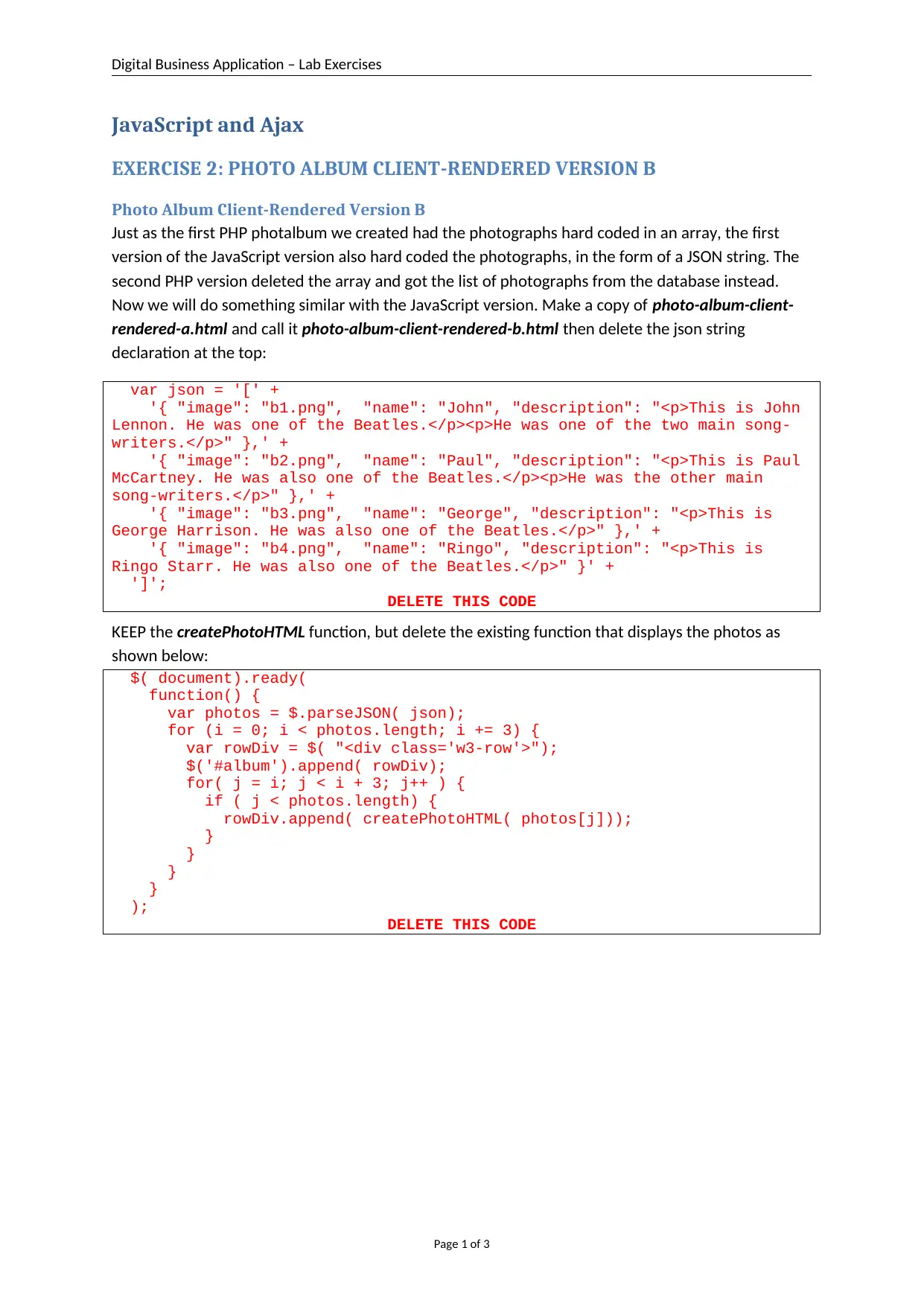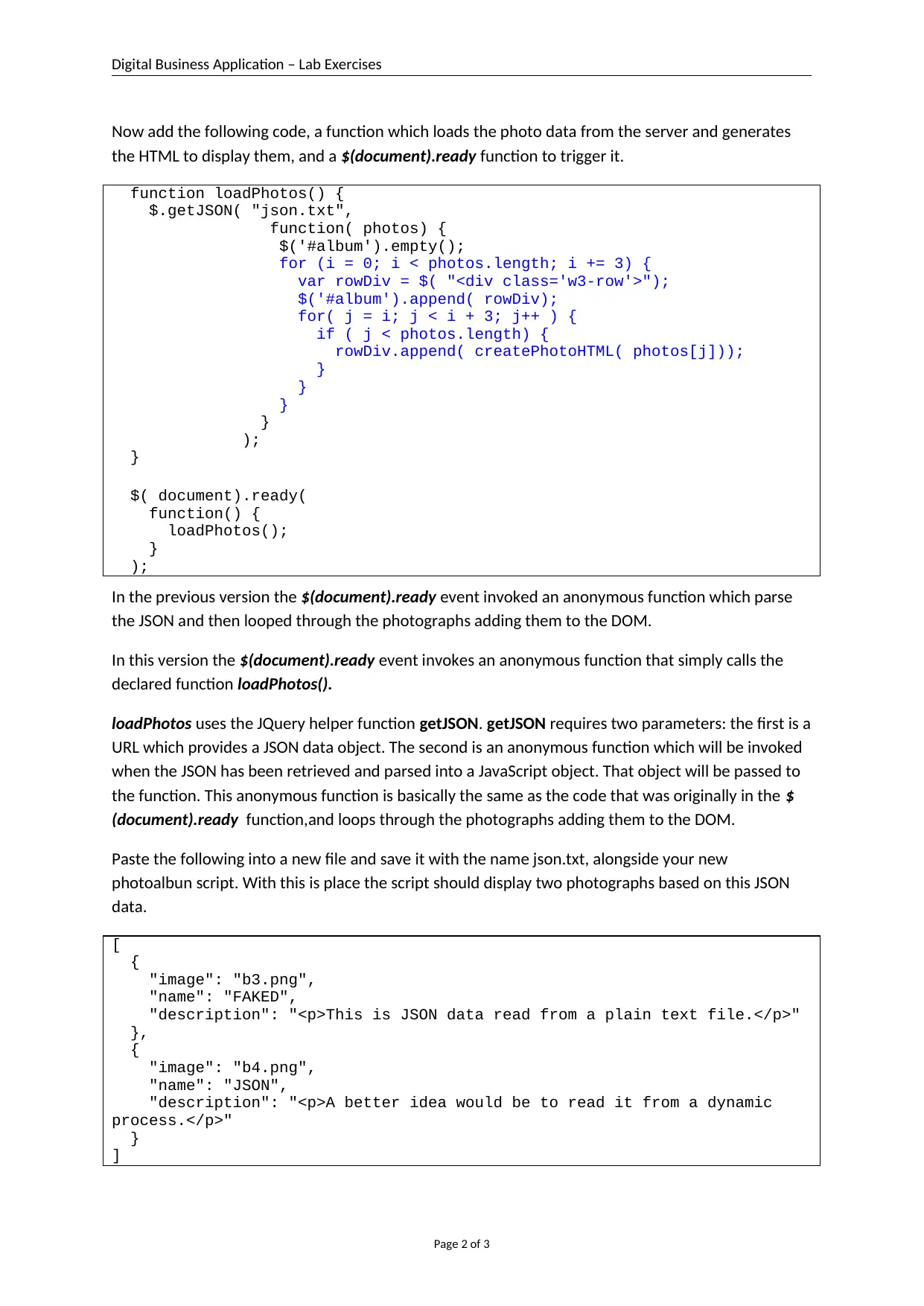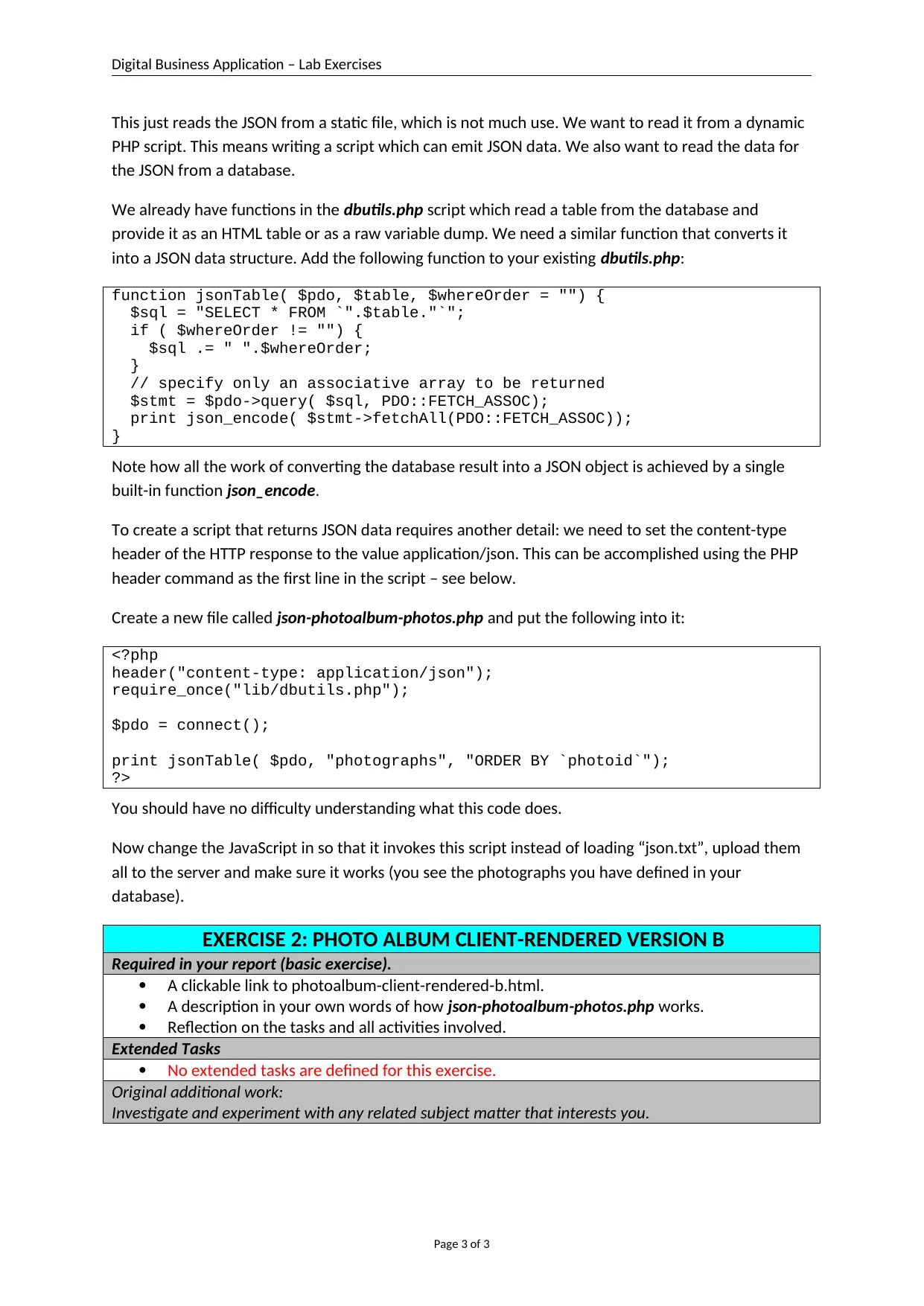Digital Business App Lab: Photo Album
VerifiedAdded on 2019/09/16
|3
|1334
|288
Practical Assignment
AI Summary
This practical assignment focuses on developing a client-rendered photo album using JavaScript, Ajax, and JSON. The exercise involves modifying an existing HTML file to load photo data dynamically from a server using a PHP script that retrieves data from a database. Students are required to create a new PHP script to output JSON data, update the JavaScript code to fetch this data, and display the photos. The assignment also includes a report component, requiring a clickable link to the completed HTML file, a description of the PHP script's functionality, and a reflection on the tasks involved.

Digital Business Application – Lab Exercises
JavaScript and Ajax
EXERCISE 2: PHOTO ALBUM CLIENT-RENDERED VERSION B
Photo Album Client-Rendered Version B
Just as the first PHP photalbum we created had the photographs hard coded in an array, the first
version of the JavaScript version also hard coded the photographs, in the form of a JSON string. The
second PHP version deleted the array and got the list of photographs from the database instead.
Now we will do something similar with the JavaScript version. Make a copy of photo-album-client-
rendered-a.html and call it photo-album-client-rendered-b.html then delete the json string
declaration at the top:
var json = '[' +
'{ "image": "b1.png", "name": "John", "description": "<p>This is John
Lennon. He was one of the Beatles.</p><p>He was one of the two main song-
writers.</p>" },' +
'{ "image": "b2.png", "name": "Paul", "description": "<p>This is Paul
McCartney. He was also one of the Beatles.</p><p>He was the other main
song-writers.</p>" },' +
'{ "image": "b3.png", "name": "George", "description": "<p>This is
George Harrison. He was also one of the Beatles.</p>" },' +
'{ "image": "b4.png", "name": "Ringo", "description": "<p>This is
Ringo Starr. He was also one of the Beatles.</p>" }' +
']';
DELETE THIS CODE
KEEP the createPhotoHTML function, but delete the existing function that displays the photos as
shown below:
$( document).ready(
function() {
var photos = $.parseJSON( json);
for (i = 0; i < photos.length; i += 3) {
var rowDiv = $( "<div class='w3-row'>");
$('#album').append( rowDiv);
for( j = i; j < i + 3; j++ ) {
if ( j < photos.length) {
rowDiv.append( createPhotoHTML( photos[j]));
}
}
}
}
);
DELETE THIS CODE
Page 1 of 3
JavaScript and Ajax
EXERCISE 2: PHOTO ALBUM CLIENT-RENDERED VERSION B
Photo Album Client-Rendered Version B
Just as the first PHP photalbum we created had the photographs hard coded in an array, the first
version of the JavaScript version also hard coded the photographs, in the form of a JSON string. The
second PHP version deleted the array and got the list of photographs from the database instead.
Now we will do something similar with the JavaScript version. Make a copy of photo-album-client-
rendered-a.html and call it photo-album-client-rendered-b.html then delete the json string
declaration at the top:
var json = '[' +
'{ "image": "b1.png", "name": "John", "description": "<p>This is John
Lennon. He was one of the Beatles.</p><p>He was one of the two main song-
writers.</p>" },' +
'{ "image": "b2.png", "name": "Paul", "description": "<p>This is Paul
McCartney. He was also one of the Beatles.</p><p>He was the other main
song-writers.</p>" },' +
'{ "image": "b3.png", "name": "George", "description": "<p>This is
George Harrison. He was also one of the Beatles.</p>" },' +
'{ "image": "b4.png", "name": "Ringo", "description": "<p>This is
Ringo Starr. He was also one of the Beatles.</p>" }' +
']';
DELETE THIS CODE
KEEP the createPhotoHTML function, but delete the existing function that displays the photos as
shown below:
$( document).ready(
function() {
var photos = $.parseJSON( json);
for (i = 0; i < photos.length; i += 3) {
var rowDiv = $( "<div class='w3-row'>");
$('#album').append( rowDiv);
for( j = i; j < i + 3; j++ ) {
if ( j < photos.length) {
rowDiv.append( createPhotoHTML( photos[j]));
}
}
}
}
);
DELETE THIS CODE
Page 1 of 3
Paraphrase This Document
Need a fresh take? Get an instant paraphrase of this document with our AI Paraphraser

Digital Business Application – Lab Exercises
Now add the following code, a function which loads the photo data from the server and generates
the HTML to display them, and a $(document).ready function to trigger it.
function loadPhotos() {
$.getJSON( "json.txt",
function( photos) {
$('#album').empty();
for (i = 0; i < photos.length; i += 3) {
var rowDiv = $( "<div class='w3-row'>");
$('#album').append( rowDiv);
for( j = i; j < i + 3; j++ ) {
if ( j < photos.length) {
rowDiv.append( createPhotoHTML( photos[j]));
}
}
}
}
);
}
$( document).ready(
function() {
loadPhotos();
}
);
In the previous version the $(document).ready event invoked an anonymous function which parse
the JSON and then looped through the photographs adding them to the DOM.
In this version the $(document).ready event invokes an anonymous function that simply calls the
declared function loadPhotos().
loadPhotos uses the JQuery helper function getJSON. getJSON requires two parameters: the first is a
URL which provides a JSON data object. The second is an anonymous function which will be invoked
when the JSON has been retrieved and parsed into a JavaScript object. That object will be passed to
the function. This anonymous function is basically the same as the code that was originally in the $
(document).ready function,and loops through the photographs adding them to the DOM.
Paste the following into a new file and save it with the name json.txt, alongside your new
photoalbun script. With this is place the script should display two photographs based on this JSON
data.
[
{
"image": "b3.png",
"name": "FAKED",
"description": "<p>This is JSON data read from a plain text file.</p>"
},
{
"image": "b4.png",
"name": "JSON",
"description": "<p>A better idea would be to read it from a dynamic
process.</p>"
}
]
Page 2 of 3
Now add the following code, a function which loads the photo data from the server and generates
the HTML to display them, and a $(document).ready function to trigger it.
function loadPhotos() {
$.getJSON( "json.txt",
function( photos) {
$('#album').empty();
for (i = 0; i < photos.length; i += 3) {
var rowDiv = $( "<div class='w3-row'>");
$('#album').append( rowDiv);
for( j = i; j < i + 3; j++ ) {
if ( j < photos.length) {
rowDiv.append( createPhotoHTML( photos[j]));
}
}
}
}
);
}
$( document).ready(
function() {
loadPhotos();
}
);
In the previous version the $(document).ready event invoked an anonymous function which parse
the JSON and then looped through the photographs adding them to the DOM.
In this version the $(document).ready event invokes an anonymous function that simply calls the
declared function loadPhotos().
loadPhotos uses the JQuery helper function getJSON. getJSON requires two parameters: the first is a
URL which provides a JSON data object. The second is an anonymous function which will be invoked
when the JSON has been retrieved and parsed into a JavaScript object. That object will be passed to
the function. This anonymous function is basically the same as the code that was originally in the $
(document).ready function,and loops through the photographs adding them to the DOM.
Paste the following into a new file and save it with the name json.txt, alongside your new
photoalbun script. With this is place the script should display two photographs based on this JSON
data.
[
{
"image": "b3.png",
"name": "FAKED",
"description": "<p>This is JSON data read from a plain text file.</p>"
},
{
"image": "b4.png",
"name": "JSON",
"description": "<p>A better idea would be to read it from a dynamic
process.</p>"
}
]
Page 2 of 3

Digital Business Application – Lab Exercises
This just reads the JSON from a static file, which is not much use. We want to read it from a dynamic
PHP script. This means writing a script which can emit JSON data. We also want to read the data for
the JSON from a database.
We already have functions in the dbutils.php script which read a table from the database and
provide it as an HTML table or as a raw variable dump. We need a similar function that converts it
into a JSON data structure. Add the following function to your existing dbutils.php:
function jsonTable( $pdo, $table, $whereOrder = "") {
$sql = "SELECT * FROM `".$table."`";
if ( $whereOrder != "") {
$sql .= " ".$whereOrder;
}
// specify only an associative array to be returned
$stmt = $pdo->query( $sql, PDO::FETCH_ASSOC);
print json_encode( $stmt->fetchAll(PDO::FETCH_ASSOC));
}
Note how all the work of converting the database result into a JSON object is achieved by a single
built-in function json_encode.
To create a script that returns JSON data requires another detail: we need to set the content-type
header of the HTTP response to the value application/json. This can be accomplished using the PHP
header command as the first line in the script – see below.
Create a new file called json-photoalbum-photos.php and put the following into it:
<?php
header("content-type: application/json");
require_once("lib/dbutils.php");
$pdo = connect();
print jsonTable( $pdo, "photographs", "ORDER BY `photoid`");
?>
You should have no difficulty understanding what this code does.
Now change the JavaScript in so that it invokes this script instead of loading “json.txt”, upload them
all to the server and make sure it works (you see the photographs you have defined in your
database).
EXERCISE 2: PHOTO ALBUM CLIENT-RENDERED VERSION B
Required in your report (basic exercise).
A clickable link to photoalbum-client-rendered-b.html.
A description in your own words of how json-photoalbum-photos.php works.
Reflection on the tasks and all activities involved.
Extended Tasks
No extended tasks are defined for this exercise.
Original additional work:
Investigate and experiment with any related subject matter that interests you.
Page 3 of 3
This just reads the JSON from a static file, which is not much use. We want to read it from a dynamic
PHP script. This means writing a script which can emit JSON data. We also want to read the data for
the JSON from a database.
We already have functions in the dbutils.php script which read a table from the database and
provide it as an HTML table or as a raw variable dump. We need a similar function that converts it
into a JSON data structure. Add the following function to your existing dbutils.php:
function jsonTable( $pdo, $table, $whereOrder = "") {
$sql = "SELECT * FROM `".$table."`";
if ( $whereOrder != "") {
$sql .= " ".$whereOrder;
}
// specify only an associative array to be returned
$stmt = $pdo->query( $sql, PDO::FETCH_ASSOC);
print json_encode( $stmt->fetchAll(PDO::FETCH_ASSOC));
}
Note how all the work of converting the database result into a JSON object is achieved by a single
built-in function json_encode.
To create a script that returns JSON data requires another detail: we need to set the content-type
header of the HTTP response to the value application/json. This can be accomplished using the PHP
header command as the first line in the script – see below.
Create a new file called json-photoalbum-photos.php and put the following into it:
<?php
header("content-type: application/json");
require_once("lib/dbutils.php");
$pdo = connect();
print jsonTable( $pdo, "photographs", "ORDER BY `photoid`");
?>
You should have no difficulty understanding what this code does.
Now change the JavaScript in so that it invokes this script instead of loading “json.txt”, upload them
all to the server and make sure it works (you see the photographs you have defined in your
database).
EXERCISE 2: PHOTO ALBUM CLIENT-RENDERED VERSION B
Required in your report (basic exercise).
A clickable link to photoalbum-client-rendered-b.html.
A description in your own words of how json-photoalbum-photos.php works.
Reflection on the tasks and all activities involved.
Extended Tasks
No extended tasks are defined for this exercise.
Original additional work:
Investigate and experiment with any related subject matter that interests you.
Page 3 of 3
⊘ This is a preview!⊘
Do you want full access?
Subscribe today to unlock all pages.

Trusted by 1+ million students worldwide
1 out of 3
Your All-in-One AI-Powered Toolkit for Academic Success.
+13062052269
info@desklib.com
Available 24*7 on WhatsApp / Email
![[object Object]](/_next/static/media/star-bottom.7253800d.svg)
Unlock your academic potential
Copyright © 2020–2025 A2Z Services. All Rights Reserved. Developed and managed by ZUCOL.


